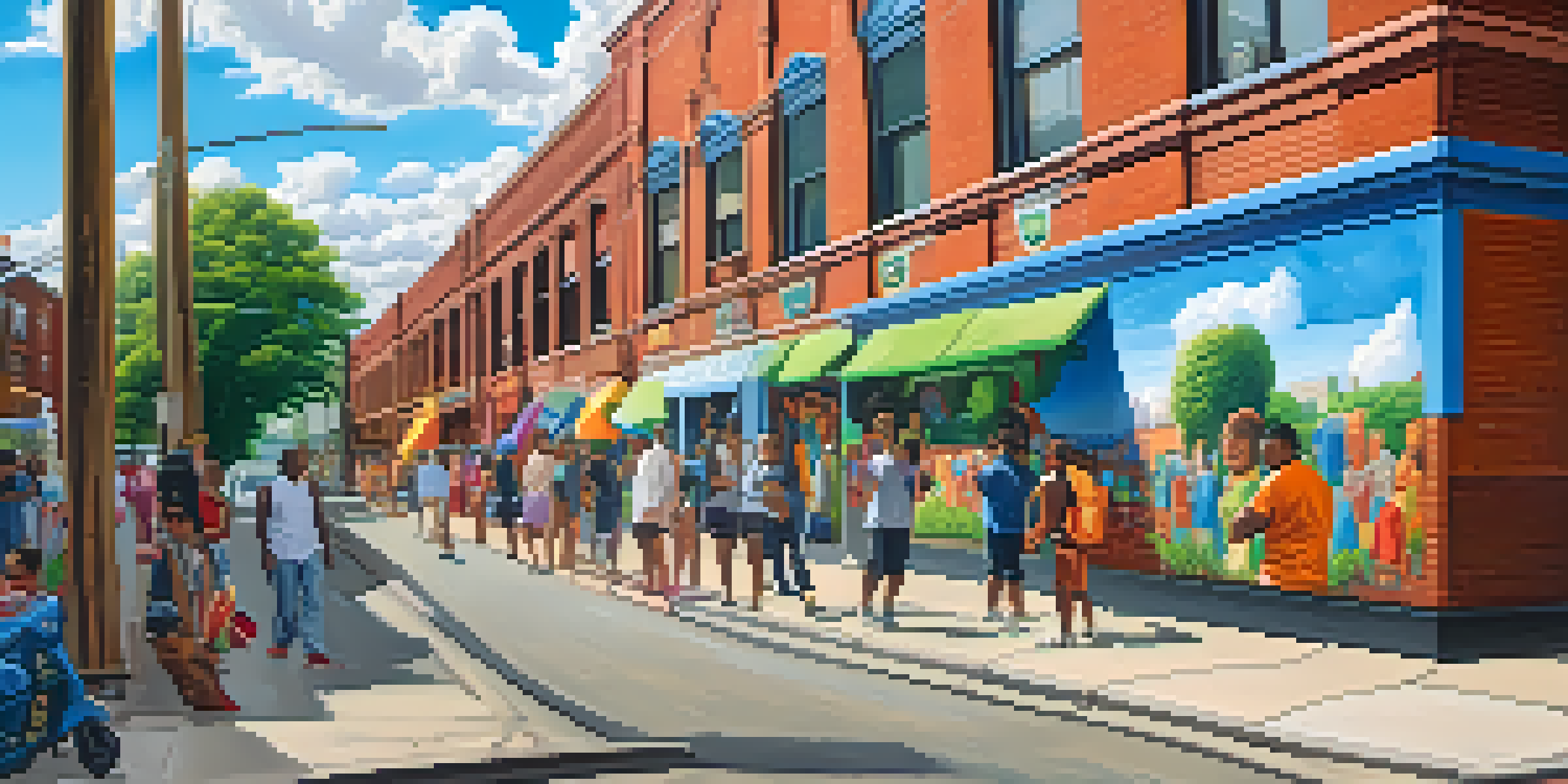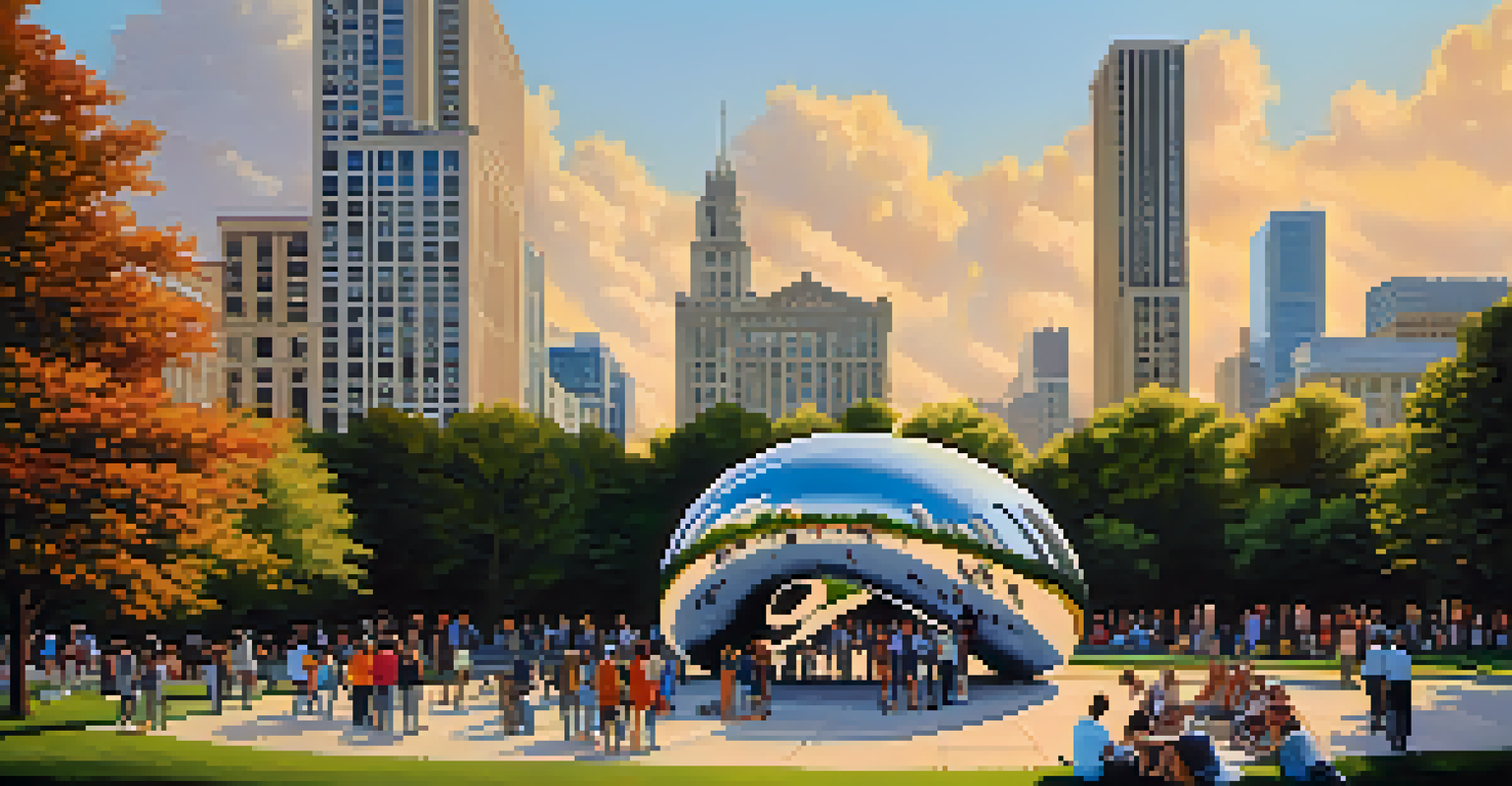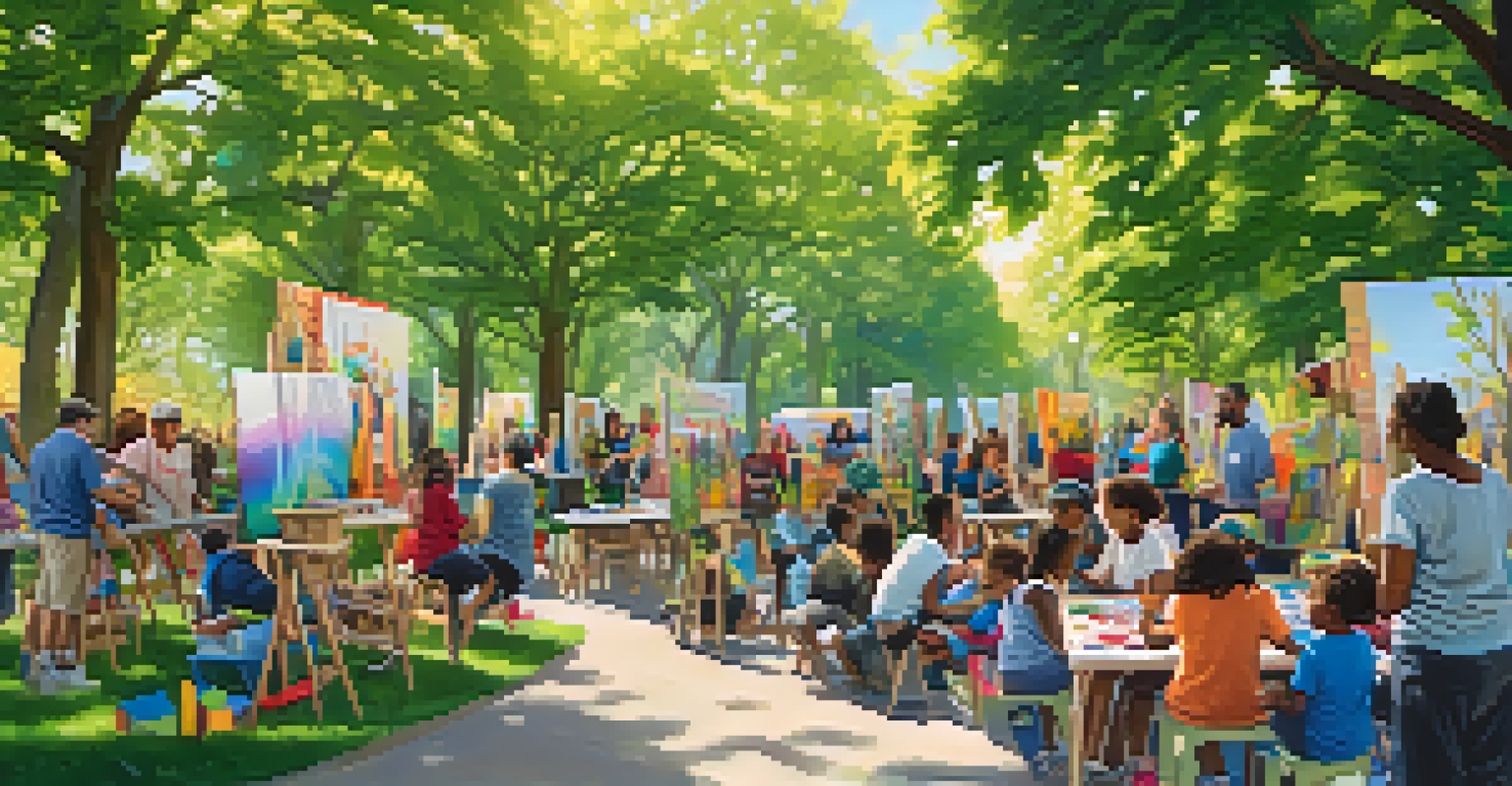Exploring the Impact of Chicago's Art Scene on Local Communities

The Heart of Chicago: An Overview of Its Art Scene
Chicago's art scene is a vibrant tapestry woven from diverse cultural threads. From the iconic murals of Pilsen to the contemporary exhibits at the Museum of Contemporary Art, each corner of the city showcases its creative spirit. This rich environment fosters not only artistic expression but also community engagement, making art an integral part of everyday life in Chicago.
Art enables us to find ourselves and lose ourselves at the same time.
Art in Chicago isn't just confined to galleries; it spills onto the streets, transforming public spaces into open-air exhibitions. This accessibility encourages participation from all walks of life, allowing communities to connect through shared experiences. As a result, art becomes a common language, bridging gaps between different neighborhoods and cultures.
Moreover, the city hosts numerous festivals, such as the Chicago Arts Festival and the Chicago Jazz Festival, celebrating artistic diversity. These events not only highlight local talent but also draw visitors, creating a sense of pride and ownership among residents. In essence, Chicago's art scene is a reflection of its community's heartbeat.
Art as a Catalyst for Community Development
Art has the power to revitalize neighborhoods, transforming neglected areas into thriving cultural hubs. For example, the redevelopment of the West Loop has been significantly influenced by its art galleries and studios, attracting new businesses and residents alike. This transformation not only enhances the local economy but also fosters a sense of belonging among community members.

Public art projects, such as those initiated by the Chicago Public Art Program, engage residents in the creative process. These initiatives allow locals to collaborate on murals or sculptures that reflect their community's unique stories and values. As a result, these projects not only beautify public spaces but also instill a sense of pride and ownership among residents.
Art Revitalizes Communities
Art has the power to transform neglected neighborhoods into vibrant cultural hubs, fostering economic growth and community pride.
Furthermore, art can serve as a tool for social change, addressing issues like inequality and injustice. Many local artists use their work to raise awareness about community challenges, sparking important conversations. This proactive approach empowers residents to take action, making art a catalyst for positive change in their neighborhoods.
Fostering Inclusion Through Artistic Expression
Chicago's art scene is a melting pot of cultures, reflecting the city's rich diversity. Artists from various backgrounds contribute their unique perspectives, creating a vibrant dialogue that enriches the community. This inclusivity encourages individuals to share their stories, fostering understanding and empathy among neighbors.
The role of the artist is to ask questions, not to answer them.
Organizations like the Chicago Cultural Alliance work tirelessly to promote cultural heritage through the arts. By providing platforms for underrepresented artists, they ensure that all voices are heard and celebrated. This commitment to inclusion not only enhances the artistic landscape but also strengthens community bonds.
Moreover, art education programs in local schools and community centers play a crucial role in fostering inclusion. By introducing children to various art forms and encouraging self-expression, these programs cultivate creativity and confidence. Ultimately, they empower the next generation to embrace their identities and contribute to the city's artistic legacy.
The Role of Local Businesses in Supporting the Arts
Local businesses play a vital role in nurturing Chicago's art scene, often collaborating with artists to create unique experiences. From hosting art shows to sponsoring public art installations, these partnerships benefit both the artists and the community. This symbiotic relationship helps to drive foot traffic to businesses while promoting local talent.
Moreover, businesses that invest in the arts often enjoy enhanced brand loyalty and community support. For instance, cafes and boutiques that display local artwork create a warm, inviting atmosphere that resonates with customers. This not only enriches the customer experience but also establishes a deeper connection between the business and the community.
Inclusivity in Artistic Expression
Chicago's art scene thrives on diversity, allowing various cultural perspectives to enrich the community and promote understanding.
Additionally, by funding art programs and initiatives, local businesses contribute to the overall cultural vibrancy of the city. These investments help sustain workshops, exhibitions, and performances that might otherwise lack financial support. Ultimately, the collaboration between local businesses and the art community strengthens the city's cultural fabric.
Public Art: Making Art Accessible to All
Public art is a powerful means of making art accessible to everyone, regardless of their background. Chicago is home to remarkable installations like the Cloud Gate and the murals that grace countless buildings throughout the city. These pieces invite interaction and engagement, allowing residents and visitors to experience art in their everyday lives.
The city's commitment to public art can be seen in initiatives like the Chicago Public Art Program, which aims to enhance public spaces through creative expression. These projects often involve community input, ensuring that the artwork reflects the identity and values of the neighborhood. This collaborative approach fosters a sense of ownership among residents.
Moreover, public art can spark conversations and inspire change. Many pieces address social issues, prompting viewers to reflect on their surroundings and engage with their community. By integrating art into public spaces, Chicago not only beautifies its city but also encourages dialogue and connection among its residents.
Art as a Tool for Healing and Resilience
In times of crisis, art can serve as a source of comfort and healing for individuals and communities. Chicago has witnessed this firsthand, especially during challenging times when artists have used their work to process grief and express solidarity. This therapeutic aspect of art fosters resilience and encourages communities to come together in support of one another.
Programs like the Chicago Arts Partnerships in Education (CAPE) focus on using the arts as a means of healing and expression in schools. By incorporating creative practices into the curriculum, students are given a safe space to explore their emotions and experiences. This approach not only aids in personal growth but also strengthens the community as a whole.
Public Art Engages Everyone
Public art initiatives make creative expression accessible to all, encouraging community dialogue and interaction in everyday spaces.
Additionally, community art projects can provide a sense of purpose and hope, especially in neighborhoods facing adversity. By collaborating on creative initiatives, residents can reclaim their spaces and foster a sense of agency. In this way, art becomes a powerful tool for resilience, helping communities navigate challenges together.
The Future of Chicago's Art Scene and Community Engagement
As Chicago's art scene continues to evolve, the importance of community engagement remains paramount. New initiatives and collaborations are emerging, aiming to involve local residents in decision-making processes around art and culture. This inclusive approach ensures that the city's artistic future reflects the diverse voices of its communities.
Technology also plays a significant role in shaping the future of art in Chicago. Virtual galleries and online platforms are making art more accessible, allowing residents to engage with local artists from the comfort of their homes. This shift not only broadens the audience but also creates new opportunities for artists to showcase their work.

Ultimately, the future of Chicago's art scene rests on the foundation of collaboration and inclusivity. By prioritizing community engagement and leveraging technology, the city can continue to thrive as a cultural hub, enriching the lives of its residents and visitors alike.